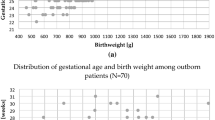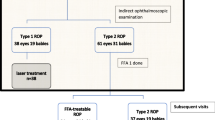Abstract
Objective
To report the demographic profile and clinical characteristics of retinopathy of prematurity (ROP) in posterior Zone I.
Methods
In a partly retrospective (ten years) and partly prospective (one year) study, we analysed the demographic profile and clinical characteristics of babies with ROP in posterior Zone I.
Results
The study included 130 eyes of 67 infants with a mean gestational age and birth weight of 29.3 (±2.2) weeks and 1217.3 (±381.9) grams, respectively. All babies had received unblended oxygen. In 47 of 51 (91.1%) babies, the weekly weight gain was <100 g (details were not available in 16 babies). The ROP subtypes included aggressive, threshold, hybrid, stage 4, and atypical types in 78 (60%), 20 (15.4%), 11 (8.5%), 15 (11.5%), and 6 (4.6%) eyes, respectively. Fibrovascular proliferation, when present, was prominent nasally, occasionally overriding the disc margin. Extensive arteriovenous tortuosity was more prominent than vascular dilatation. Atypical observations included bleb-like detachment (6 eyes; 4.6%) and candle wax-like preretinal deposits (23 eyes; 17.7%).
Conclusions
Retinopathy of Prematurity in posterior Zone I in this cohort was strongly associated with 100% unblended oxygen supplementation, poor weight gain, and multiple systemic co-morbidities. ROP in posterior zone 1 has a distinct profile with several atypical characteristics different from ROP in other zones.
This is a preview of subscription content, access via your institution
Access options
Subscribe to this journal
Receive 18 print issues and online access
$259.00 per year
only $14.39 per issue
Buy this article
- Purchase on Springer Link
- Instant access to full article PDF
Prices may be subject to local taxes which are calculated during checkout


Similar content being viewed by others
Data availability
The datasets generated during and/or analysed during the current study are available from the corresponding author on reasonable request.
References
Shah PK, Narendran V, Kalpana N. Aggressive posterior retinopathy of prematurity in large preterm babies in South India. Arch Dis Child Fetal Neonatal Ed. 2012;97:F371–375. https://doi.org/10.1136/fetalneonatal-2011.
Jalali S, Kesarwani S, Hussain A. Outcomes of a protocol-based management for zone 1 retinopathy of prematurity: the Indian Twin Cities ROP Screening Program report number 2. Am J Ophthalmol. 2011;151:719–24.
Kychenthal A, Dorta P, Katz X. Zone I retinopathy of prematurity: clinical characteristics and treatment outcomes. Retina. 2006;26:S11–5.
Cryotherapy for Retinopathy of Prematurity Cooperative Group. Multicentre for trial for cryotherapy of retinopathy of prematurity: three-month outcome. Arch Ophthalmol. 1990;108:195–204.
WV; Early Treatment for Retinopathy of Prematurity Cooperative Group. The early treatment for retinopathy of prematurity study: structural findings at age 2 years. Br J Ophthalmol. 2006;90:1378–82.
Katoch D, Dogra MR, Aggarwal K, Sanghi G, Samanta R, Handa S, et al. Posterior zone I retinopathy of prematurity: spectrum of disease and outcome after laser treatment. Can J Ophthalmol. 2019;54:87–93.
Parchand SM, Agrawal D, Gangwe A, Saraogi T, Agrawal D. Combined intravitreal ranibizumab and zone I sparing laser ablation in infants with posterior zone I retinopathy of prematurity. Indian J Ophthalmol. 2021;69:2164–70.
Sachan A, Chandra P, Chandra Lakshmi C, Chawla R, Shah PR, Kumar A. Clinical profile and management outcomes of posterior zone 1 retinopathy of prematurity. Int Ophthalmol. 2022;42:3303–9. https://doi.org/10.1007/s10792-022-02329-y.
Pjaver RK, Bilagi AP, Vinekar A, Deorari AK, Jalali S. Evidence based ROP guidelines in the NNF evidence based guidelines. (2010). P. 253-63. Available from http:aimaonline.org/iap-neochap-2013/uploads/acdcorner/nnf_guidelines-2011.pdf. Last accessed Feb 17, 2023.
Guidelines for Universal Eye Screening in Newborns Including Retinopathy of Prematurity [Internet]. Rashtriyabalswasthya karyakram; 2017. Available karyakram; 2017. Available from: https://www.nhm.gov.in/images/pdf/programmes/RBSK/Resource_Documents/Revised_ROP_Guidelines-Web_Optimized.pdf-Google Search [Internet]. Last accessed Feb 17, 2023.
Chiang MF, Quinn GE, Fielder AR, Ostmo SR, Paul Chan RV, Berrocal A, et al. International classification of retinopathy of prematurity, third edition. Ophthalmology. 2021;128:e51–68.
De Silva DJ, Cocker KD, Lau G, Clay ST, Fielder AR, Moseley MJ. Optic disk size and optic disk-to-fovea distance in preterm and full-term infants. Invest Ophthalmol Vis Sci. 2006;47:4683–6.
Vinekar A. “Timing of laser following intravitreal anti-vascular endothelial growth factor injections for aggressive posterior zone 1 retinopathy of prematurity.”. Indian J Ophthalmol. 2021;69:1988–9.
The Committee for the Classification of Retinopathy of Pre-maturity. An international classification of retinopathy of prematurity. Arch Ophthalmol. 1984;102:1130–4.
An international classification of retinopathy of prematurity. II. The classification of retinal detachment. The international committee for the classification of the late stages of retinopathy of prematurity. Arch Ophthalmol. 1987;105:906–12.
Committee for the Classification of Retinopathy of Prematurity. The international classification of retinopathy of pre-maturity revisited. Arch Ophthalmol. 2005;123:991e999.
Sanghi G, Dogra MR, Dogra M, Katoch D, Gupta A. A hybrid form of retinopathy of prematurity. Br J Ophthalmol. 2012;96:519–22. https://doi.org/10.1136/bjophthalmol-2011-300321.
Padhi TR, Bhusal U, Padhy SK, Patel A, Kelgaonker A, Khalsa A, et al. The retinal vascular growth rate in babies with retinopathy of prematurity could indicate treatment need. Indian J Ophthalmol. 2022;70:1270–7.
Ritch R, Shields MB, Krupin T. The Glucomas. 1067. St. Louis, MO: Mosby; 1989.
Section on Ophthalmology American Academy of Pediatrics; American Academy of Ophthalmology; American Association for Pediatric Ophthalmology and Strabismus. Screening examination of premature infants for retinopathy of prematurity. Pediatrics. 2006;117:572–6. https://doi.org/10.1542/peds.2005-2749.
Sanghi G, Dogra MR, Katoch D, Gupta A. Aggressive posterior retinopathy of prematurity in infants ≥1500 g birth weight. Indian J Ophthalmol. 2014;62:254–7. https://doi.org/10.4103/0301-4738.128639.
Kim SJ, Port AD, Swan R, Campbell JP, Chan RVP, Chiang MF. Retinopathy of prematurity: a review of risk factors and their clinical significance. SurvOphthalmol. 2018;63:618–37.
Wallace DK, Kylstra JA, Phillips SJ, Hall JG. Poor postnatal weight gain: a risk factor for severe retinopathy of prematurity. J AAPOS. 2000;4:343–7.
Allegaert K, Vanhole C, Casteels I, Naulaers G, Debeer A, Cossey V, et al. Perinatal growth characteristics and associated risk of developing threshold retinopathy of prematurity. J AAPOS. 2003;7:34–37. https://doi.org/10.1067/mpa.2003.S1091853102420150.
Kim J, Jin JY, Kim SS. Postnatal weight gain in the first two weeks as a predicting factor of severe retinopathy of prematurity requiring treatment.”. Korean J Pediatr. 2015;58:52–9. https://doi.org/10.3345/kjp.2015.58.2.52.
Provis JM. Development of the primate retinal vasculature. Prog Retin Eye Res. 2001;20:799–821. https://doi.org/10.1016/s1350-9462(01)00012-x.
Pau H. Hypothesis on the pathogenesis of retinopathy of prematurity–it is not VEGF alone but anatomical structures that are crucial. Graefes Arch Clin Exp Ophthalmol 2010;248:1–3. https://doi.org/10.1007/s00417-009-1190-7.
Patel A, Padhy SK, Saoji K, Saldna M, Multani PK, Khalsa A, Kelgaonkar A, Bhusal U. Bleb-like posterior combined retinal detachment in severe retinopathy of prematurity: clinical characteristics, management challenges and outcome. Eye. 2021;35:3152–5.
Shah MS, Padhy SK, Sahu S, Padhi TR. Atypical case of retinopathy of prematurity with candle wax-like preretinal deposits and its surprising response to intravitreal anti-vascular endothelial growth factor. BMJ Case Rep. 2022;15:e244998.
Acknowledgements
We acknowledge Mr. Abhinav Sekar for his help in editing and language check in the manuscript.
Funding
Hyderabad Eye Research Foundation, Hyderabad, India. Though not directly related to this project, the institute’s ROP program as a whole has been supported by the Miriam Hyman Memorial Trust, London; Queen Elizabeth Diamond Jubilee Trust, London; Public Health Foundation of India, Rashtriya Bal Swasthya Karyakram, India; Dalmia Holdings, New Delhi; and Cognizant Foundation at different point of time.
Author information
Authors and Affiliations
Contributions
TRP: Concept, data acquisition, analysis, Interpretation, preparation of the draft. Critical revision, final approval, and agree to be accountable for all aspects of the work. MS: Data acquisition, analysis, preparation of the draft, critical revision, final approval, and agree to be accountable for all aspects of the work. SUS: Data acquisition, preparation of the draft, critical revision, final approval, and agree to be accountable for all aspects of the work. TD: Data analysis, Critical revision, final approval. UTB: Data acquisition, preparation of the draft, final approval, and agree to be accountable for all aspects of the work. AS: Data acquisition, preparation of the draft, critical revision, final approval, and agree to be accountable for all aspects of the work. SBN: Data acquisition, preparation of the draft, critical revision, final approval, and agree to be accountable for all aspects of the work. SN: Data acquisition, critical revision, final approval, and agree to be accountable for all aspects of the work. SAN: Concept and design, analysis, interpretation, preparation of the draft, critical revision, final approval, and agree to be accountable for all aspects of the work. BVP: Concept and design, analysis, preparation of the draft, critical revision, final approval, and agree to be accountable for all aspects of the work. KA: Concept and design, analysis, interpretation of the draft, critical revision, final approval, and agree to be accountable for all aspects of the work. BKS: Data collection, interpretation, preparation of the draft, critical revision, final approval, and agree to be accountable for all aspects of the work. SD: Data collection, interpretation, preparation of the draft, critical revision, final approval, and agree to be accountable for all aspects of the work. KSR: Data collection, interpretation, preparation of the draft, critical revision, final approval, and agree to be accountable for all aspects of the work. LP: Data collection, interpretation, preparation of the draft, critical revision, final approval, and agree to be accountable for all aspects of the work. SJ: Concept, design, analysis, interpretation, preparation of the draft, critical revision, final approval, and agree to be accountable for all aspects of the work.
Corresponding author
Ethics declarations
Competing interests
The authors declare no competing interests.
Additional information
Publisher’s note Springer Nature remains neutral with regard to jurisdictional claims in published maps and institutional affiliations.
Rights and permissions
Springer Nature or its licensor (e.g. a society or other partner) holds exclusive rights to this article under a publishing agreement with the author(s) or other rightsholder(s); author self-archiving of the accepted manuscript version of this article is solely governed by the terms of such publishing agreement and applicable law.
About this article
Cite this article
Padhi, T.R., Shah, M., Sahoo, S. et al. Characteristics of posterior zone I retinopathy of prematurity. Eye 37, 3776–3780 (2023). https://doi.org/10.1038/s41433-023-02603-y
Received:
Revised:
Accepted:
Published:
Issue Date:
DOI: https://doi.org/10.1038/s41433-023-02603-y



